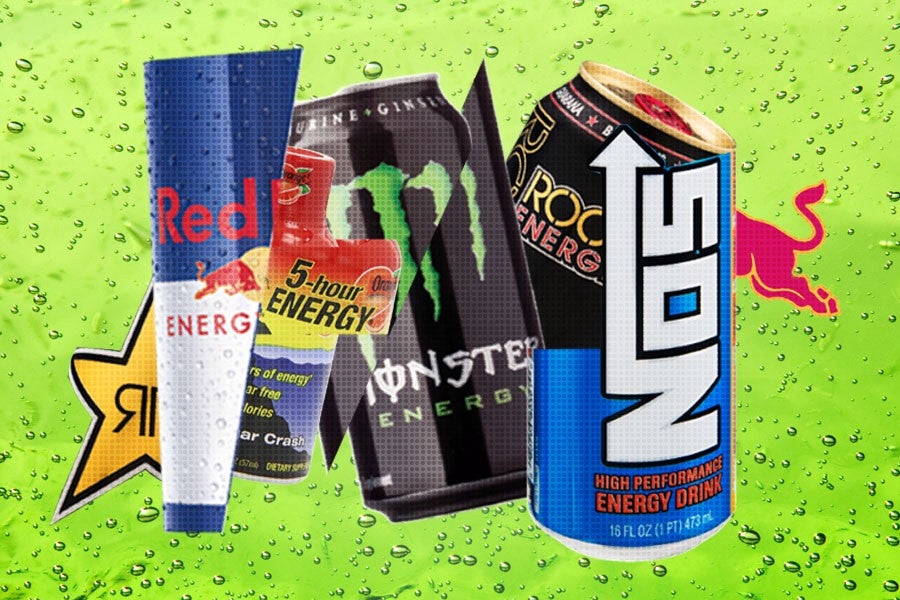When I asked Dana Hunnes, senior dietitian at the Ronald Reagan UCLA Medical Center, to help me rank popular energy drinks by how healthy they are, she immediately (and firmly) responded by saying it was impossible, for the simple reason that there’s no such thing as a healthy energy drink, period. “I don’t recommend any of these drinks for regular consumption,” Hunnes emphasizes. “They’re nothing more than carbonated, caffeinated and colored vitamin drinks, which can be dangerous when over-consumed, leading to arrhythmia, sleeplessness and possibly even anxiety.”
She’s right: Caffeine overdoses associated with energy drinks are surprisingly common, which might explain why multiple countries — the U.K., Lithuania, Latvia, Denmark, Turkey, Norway, Uruguay, Iceland and France — have implemented restrictions on the sales of them to minors. “The basic premise of energy drinks is nutritional reductionism — taking the ‘best’ parts from foods and putting them in a bottle to sell for profit,” Hunnes explains. “But when nutrients and vitamins are isolated, they rarely behave how they might when they’re consumed as the entire food product that they were derived from (which is nutritional wholism).”
“The main ‘energy’ booster in these drinks is caffeine,” Hunnes continues. “The rest are glorified vitamins, which as I mentioned, have been proven by journals to not do much more than act as a placebo when in isolation.”
With that in mind, let’s rank some energy drinks before my heart gives out.
1. Yerba Mate: “This appears to be the healthiest, since it has no artificial ingredients,” Hunnes says. “It also appears to be derived from yerba mate, which is probably extremely healthy when eaten as a whole, since it contains antioxidants, vitamins and minerals. However, when distilled down — as it is in this drink — it probably doesn’t provide much in the way of any of those benefits, except for caffeine.”
2. Redline: “This doesn’t appear to contain any artificial colors, and it’s calorie-free, since it contains the artificial sweetener sucralose (which is ‘safe,’ according to the FDA),” Hunnes explains. “The vitamins and amino acids probably won’t do much for you at the doses that they come in, and the electrolyte portions are a bit of a joke. But overall, this seems close to Yerba Mate in terms of being least unhealthy.” It’s worth noting, however, that Redline energy drinks are extremely high in caffeine, meaning consuming more than a single serving (which amounts to only half of the bottle) may put you into the hospital.
3. 5-Hour Energy: These shots are calorie-free and contain the caffeine-equivalent of a 12-ounce cup of coffee. “It has artificial sweeteners, which may be unsafe in high doses, and we would pee out the B-vitamins that it contains,” Hunnes explains. FYI, 5-Hour Energy also comes in decaf, which makes no sense whatsoever.
4. Red Bull: A 12-ounce can of regular Red Bull contains a whopping 37 grams of sugar, which is a lot — that’s approximately 10 teaspoons, or the equivalent of about 35 gummy bears. The American Heart Association recommends that men consume no more than 36 grams and that women consume no more than 25 grams of added sugar per day. Too much sugar, if you didn’t already know, is terrible for you: A sugar-laden diet is associated with all kinds of ailments, from heart disease to depression.
Meanwhile, sugar-free Red Bull contains artificial sweeteners, which again, are possibly carcinogenic. “It has artificial coloring in it, which is also possibly carcinogenic,” says Hunnes. “It doesn’t contain as much caffeine as some of these drinks, but it’s still not a great choice.”
5. Monster: “This is about the same as Rockstar [which we’ll look at next],” Hunnes says. But it contains slightly less sugar.
6. Rockstar: A 16-ounce can of Rockstar used to contain 240 milligrams of caffeine (it looks like they recently reduced that to 160 milligrams, while their 24-ounce can boasts 240 milligrams) in addition to high-fructose corn syrup and artificial coloring. “Who needs 240 milligrams of caffeine in one sitting?” Hunnes asks, rhetorically. “That’s like two and a half cups of coffee, but in a concentrated dose.”
7. Kickstart: “This appears to contain artificial colors, high-fructose corn syrup and the artificial sweetener acesulfame K, which can potentially be carcinogenic in high doses,” Hunnes explains. “The vitamins in it also aren’t going to do much for you so long as you’re getting them from other foods: They’re all water-soluble vitamins, so you pee them out in excess of what you need.”
8. AMP: “This is like a soda with some added vitamins, colors and bad sweeteners,” Hunnes says. “It also looks to have several sources of caffeine, and could be dangerous to young kids (all of these beverages should be avoided by kids due to their caffeine content). But it’s the colors and sweeteners that concern me.”
9. NOS: “At 210 calories per can, NOS isn’t going to do much for you except add calories that you probably don’t need to your diet,” Hunnes says. “It has the same amount of caffeine as a large cup of coffee.”
10. Full Throttle: “This has a lot of refined sugars and calories in it,” Hunnes says. (She’s right — it contains a crazy-high 58 grams of sugar (that’s nearly 15 sugar cubes) and 220 calories per can.) “It’s also fairly high in caffeine, and contains about eight percent of a person’s daily sodium intake: I can think of myriad better ways to consume sodium than in this drink. Finally, it has coloring, which can be dangerous, and again, the vitamins won’t do much good.”
Welp, that was without doubt the single most unhealthy list of things I’ve ever come across while writing this series.
*Checks heart rate, pounds another Red Bull*

